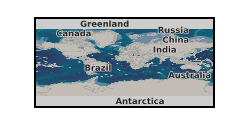A global Ediacaran-Cambrian Age Model of 130 geological successions, with radiometric ages (zircon U-Pb CA-ID-TIMS), carbon (δ13Ccarb) and strontium (87Sr/86Sr) isotope data (NERC Grant NE/T008458/1)
We present new age models for the Ediacaran-Cambrian which lacks a robust global temporal framework. This interval marks the radiation of animals, but there are major uncertainties in the evolutionary dynamics of this critical radiation and its relationship to changes in palaeoenvironmental changes. Here we present global data from 130 successions that enable us to create four new possible global age models (A to D) for the interval 551–517 million years ago (Ma). These models comprise composite carbonate carbon isotope (δ13Ccarb) curves, which are anchored to radiometric ages and consistent with strontium isotope chemostratigraphy, and are used to calibrate metazoan distribution in space and time. These models differ most prominently in the temporal position of the basal Cambrian negative δ13Ccarb excursion (BACE). Two age models (A and B) place the BACE within the Ediacaran, and yield an age of ~538.8 Ma for the Ediacaran-Cambrian boundary; however models C and D appear to be the most parsimonious and may support a recalibration of the boundary age by up to 3 Myr younger. All age models reveal a previously underappreciated degree of variability in the terminal Ediacaran, incorporating notable positive and negative excursions that precede the BACE. Nothwithstanding remaining uncertainties in chemostratigraphic correlation, all models support a pre-BACE first appearance of Cambrian-type shelly fossils in Siberia and possibly South China, and show that the Ediacaran-Cambrian transition was a protracted interval represented by a series of successive radiations. Data were compiled by Fred Bowyer, with support from Andrey Yu. Zhuravlev, Rachel Wood, Maoyan Zhu, Graham Shields, Ying Zhou, Chuang Yang, Simon Poulton, Dan Condon, Andrew Curtis.

non geographic dataset
:
http://data.bgs.ac.uk/id/dataHolding/13607887
English
Geoscientific information
GEMET - INSPIRE themes, version 1.0:
BGS Thesaurus of Geosciences:
NGDC Deposited Data
Free:
Free:
NERC_DDC
revision: 2022-01-13
University of Edinburgh
Rachel Wood
Edinburgh,
EH9 3JW,
United Kingdom
email:
not available
Role: originator
University of Edinburgh
Rachel Wood
Edinburgh,
EH9 3JW,
United Kingdom
email:
not available
Role: principal investigator
British Geological Survey
Enquiries
email:
not available
Role: distributor
British Geological Survey
Enquiries
email:
not available
Role: point of contact
Data Quality
We present a new δ13Ccarb framework for the Ediacaran Nama Group of southern Namibia. These data are correlated regionally by combined litho-, chemo-, and sequence stratigraphy, constrained in time using high precision U-Pb ages determined via zircon chemical abrasion isotope dilution thermal ionization mass spectrometry (CA-ID-TIMS). Trends in the Nama reference curve are corelated with δ13Ccarb data from globally distributed sections that are well constrained by interbedded zircon ages, and robust high-resolution regional section correlation, for the interval ~ 551 to 517 Ma in multiple regions. Compiled data act as framework curves to reveal trends in the global data that can be confidently constrained in age. These curves are used to anchor a wider correlation in order to best fit high-resolution δ13Ccarb data from key sections that lack robust radiometric constraints. This allows construction of four possible composite carbon isotope curves and age models, comprising 130 globally distributed sections (Australia, Brazil, Kazakhstan, Mongolia, Morocco, Namibia, Mexico, USA, Canada, Oman, Siberia and South China). These curves are consistent with all reliable radiometric age data and strontium isotope (87Sr/86Sr) records between ~551–517 Ma. All First Appearance Datums (FADs) and, for Ediacaran taxa, Last Appearance Datums (LADs) of key fossil occurrences are calibrated within this framework. This provides the basis for biotic temporal and spatial distributions to be accurately constrained and visualized.
INSPIRE Implementing rules laying down technical arrangements for the interoperability and harmonisation of Geology
Commission Regulation (EU) No 1089/2010 of 23 November 2010 implementing Directive 2007/2/EC of the European Parliament and of the Council as regards interoperability of spatial data sets and services
Constraints
The copyright of materials derived from the British Geological Survey's work is vested in the Natural Environment Research Council [NERC]. No part of this work may be reproduced or transmitted in any form or by any means, or stored in a retrieval system of any nature, without the prior permission of the copyright holder, via the BGS Intellectual Property Rights Manager. Use by customers of information provided by the BGS, is at the customer's own risk. In view of the disparate sources of information at BGS's disposal, including such material donated to BGS, that BGS accepts in good faith as being accurate, the Natural Environment Research Council (NERC) gives no warranty, expressed or implied, as to the quality or accuracy of the information supplied, or to the information's suitability for any use. NERC/BGS accepts no liability whatever in respect of loss, damage, injury or other occurence however caused.
Available under the Open Government Licence subject to the following acknowledgement accompanying the reproduced NERC materials "Contains NERC materials ©NERC [year]"
licenceOGL
Metadata about metadata
d6792c84-852b-72c9-e054-002128a47908
British Geological Survey
Environmental Science Centre,Keyworth,
NOTTINGHAM,
NG12 5GG,
United Kingdom
tel: +44 115 936 3100
email:
enquiries@bgs.ac.uk
Role: point of contact
2024-04-24
